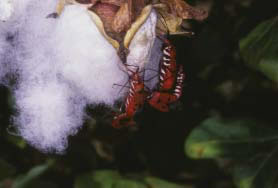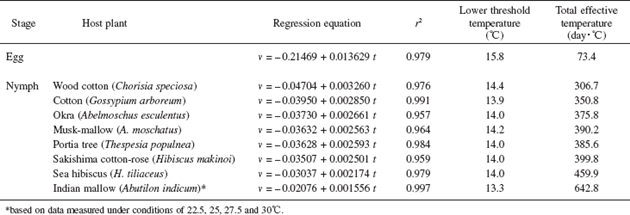Effects on the growth of the cotton stainer bug Dysdercus cingulatus when fed various host plant seeds including those of wild species
Description
[Objectives]
Cotton is the world's most widely-used natural fiber. One of the major obstacles hindering cotton production is insect pest infestation; cotton stainers (Dysdercus spp.; Heteroptera: Pyrrhocoridae), in particular, are difficult to control by insecticide application in cotton fields because they are very mobile and have many alternative host plants. Among them, Dysdercus cingulatus (Fig. 1) is the most serious pest species of cotton in southeast Asian countries, having many alternative host plants species, including malvaceous and bombacaceous plant species. Therefore, investigation of the developmental properties of bugs fed with host plants other than cotton is crucial for the prediction of the time of invasion into cotton fields and for effective pest control utilizing insecticide application. In addition, the growth of D. cingulatus including its temperature dependency was examined when fed with seeds of cotton, okra, and several other wild and ornamental plant species which are common host plants of D. cingulatus in southeast Asia and on Ishigaki island.
[Results]
Seeds of commercially-cultivated species (cotton plant Gossypium arboreum and okra plant Abelmoschus esculentus), wildly-grown species (musk-mallow A. moschatus, portia tree Thespesia populnea, Sakishima cottonrose Hibiscus makinoi, sea hibiscus H. tiliaceus and Indian mallow Abutilon indicum), and ornamental species (wood cotton Chorisia speciosa) were provided as experimental feed to examine the growth properties of D. cingulatus. The survival rates of bugs in their nymphal stages and developmental rates when fed respective plant species displayed significant correlations (p < 0.05 by Kendall'st); species that exhibited faster nymphal development also exhibited higher nymphal survival rates and vice versa. Thermal requirements for the development of D. cingulatus were estimated from data for 20, 22.5, 25, 27.5 and 30°C and 14L-10D when fed with seeds of eight different plant species are shown in Table 1. These results suggest that ornamental species (Ch. speciosa) and a few wild species, Th. populnea and H. makinoi in particular, are good host plant species for D. cingulatus as well as commercially cultivated species. Since all examined wild plant species excluding H. makinoi are commonly distributed in southeast Asian countries, of which Th. Populnea is judged to be an especially suitable host plant species for D. cingulatus, the results of this study and information on the occurrence of D. cingulatus on these plant species will form a solid foundation for the determination of insecticide application in cotton fields of southeast Asian countries.
Figure, table
-
Fig. 1. Cotton stainer bugs (Dysdercus cingulatus) sucking ripe cotton bolls. -
Table 1. Thermal requirements for the development of Dysdercus cingulatus, estimated from data for 20, 22.5, 25, 27.5 and 30°C and 14L-10D when fed seeds of eight plant species.
- Affiliation
-
Japan International Research Center for Agricultural Sciences Okinawa Subtropical Station
- Classification
-
Technical A
- Term of research
-
FY2003 (FY2002-2003)
- Responsible researcher
-
KOHNO Katsuyuki ( Okinawa Subtropical Station )
NGAN Bui Thi ( Vietnam Textile Research Institute )
- ほか
- Publication, etc.
-
Kohno, K. and Bui Thi N. (2004): Effects of host plant species on the development of Dysdercus cingulatus (Heteroptera: Pyrrhocoridae). Applied Entomology and Zoology, 39, 183-187.
- Japanese PDF
-
2003_31_A3_ja.pdf2.69 MB
- English PDF
-
2003_31_A4_en.pdf58.18 KB


